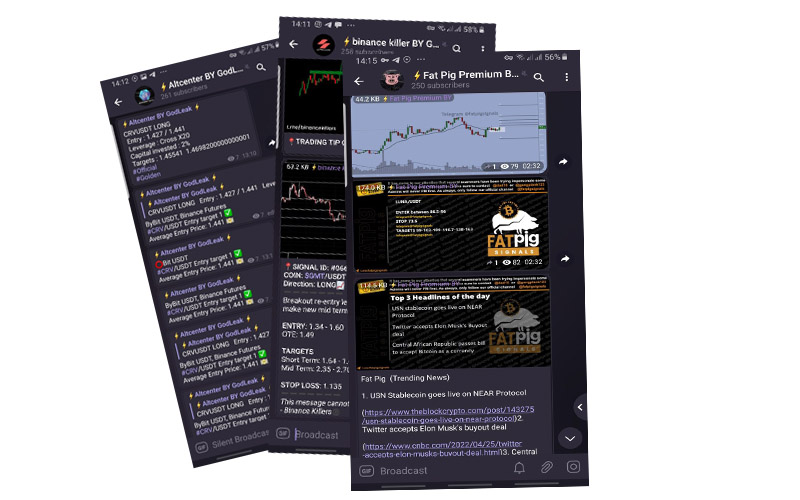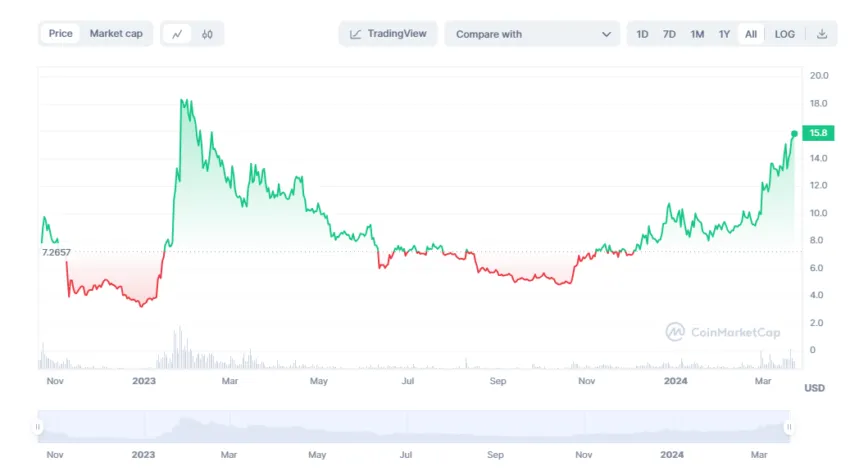Aptos Crypto (APT): A Guide to What it Is and How it Works

The Aptos project is all about making blockchain faster and easier to use, with some new security and usability features thrown in the mix. If you’re new to Aptos, it’s best to understand what it’s all about before you jump in. In this Aptos crypto explainer, we’ll break down the network and native coin APT, how it works, and where it differs from competitors. Here’s what you need to know.
Methodology
What is Aptos crypto and network?
Aptos is a layer-1 blockchain that uses the Move programming language by Facebook (Meta). Facebook developed Move as part of its project Libra (rebranded as Diem later), which ultimately didn’t launch after facing fierce opposition from policymakers.
The primary objective of Aptos is to provide users with higher scalability, security, usability, and reliability.
The Aptos genesis took place on Oct. 12, 2022, which was closely followed by the launch of the mainnet “Aptos Autumn” on Oct. 17, 2022. The project quickly became popular in investor circles, raking in significant funding. So far, the company has raised $350 million across three funding rounds.
Aptos uses the AptosBFT consensus mechanism alongside a parallel execution engine. It includes three key components that this Aptos explainer will break down, namely:
- The Move language
- The Aptos data model
- The Move module
But before we delve into the technical elements, let’s first try to understand why Aptos generated so much hype right from its infancy. In short, that early buzz had much to do with the team overseeing the project.
The Aptos team
Aptos’s link to Facebook’s Libra/Diem goes beyond the Move programming language. In many ways, it is more like the next chapter for the Libra/Diem blockchain, picking up where things left off after Facebook scrapped it in early 2022.
Aptos was developed by Aptos Labs and co-founded by Mo Shaikh and Avery Ching, who met while working on the Diem stablecoin at Meta. Shaikh, a product scaling expert with experience in investment, joined forces with Ching, a seasoned software engineer with a track record of innovation. When Diem was discontinued, the duo launched Aptos Labs with the motto “Building a layer-1 for everyone.”
The company has since raised a diverse and expanding team of engineers, developers, and strategists — all committed to implementing Diem’s original objective of creating a fast, secure, and scalable blockchain.
Get to know Godleak
Godleak crypto signal is a service which provide profitable crypto and forex signals for trading. Godleak tried to provide you signals of best crypto vip channels in the world.
It means that you don’t need to buy individual crypto signal vip channels that have expensive prices. We bought all for you and provide you the signals with bot on telegram without even a second of delay.

Godleak crypto leak service have multiple advantages in comparision with other services:
- Providing signal of +160 best crypto vip channels in the world
- Using high tech bot to forward signals
- Without even a second of delay
- Joining in +160 separated channels on telegram
- 1 month, 3 months , 6 months and yearly plans
- Also we have trial to test our services before you pay for anything
For joining Godleak and get more information about us only need to follow godleak bot on telegram and can have access to our free vip channels. click on link bellow and press start button to see all features
Join for Free
☟☟☟☟☟
https://t.me/Godleakbot
Also you can check the list of available vip signal channels in the bot. by pressing Channels button.
Backed by multiple large venture capital groups, Aptos Labs has already launched its developer testnet. It also claims to have processed thousands of nodes and billions of transactions in a day.
“In a mainnet-like testing environment, Aptos achieved a peak of 30,000 TPS and over 2 billion transactions in a day. Upgrades enabling the high performance, such as storage sharding and novel NFT solution Aggregators, will roll out on mainnet in 2024.”
— the Aptos team announced in Feb 2024.
Aptos explainer: Under the hood
Let’s take a more technical look into the three key components we mentioned earlier: Move language, Aptos data model, and Move module.
The Move language
Aptos uses the Move programming language to define the state of its ledger. Move prioritizes safety and flexibility and, unlike traditional languages, relies on modules that clearly define the rules governing transactions within the system. This way, users can interact with Aptos in several different ways.
For instance, you can submit transactions that publish new modules or upgrade already existing ones. Similarly, it is also possible to trigger specific functions or to deploy scripts that interact with those modules.
Overall, Move brings along a developer-friendly ecosystem that includes a compiler, a virtual machine, as well as a host of other resources. However, what truly sets Move apart is its razor-sharp focus on security. It uses a bytecode verifier that guarantees memory and type safety to ensure the safety of your data and prevent resource misuse, even when running potentially risky code.
Additionally, developers can leverage the Move Prover, a tool that verifies a program’s functionality against pre-defined specifications, which usually yields more reliable code. The Aptos team has further refined Move to make it suitable for a wide range of web3 applications, as outlined in its whitepaper.
Aptos data model
In layman’s terms, the Aptos blockchain functions like a giant record book. Each account in this ledger has a unique version number that goes up every time a transaction happens. Anyone can submit a transaction to update this record book.
Each transaction includes details like:
- How it’s verified: This could be a digital signature or other security measure.
- Who sent it: The sender’s account address.
- What it does: The specific instructions for the transaction.
- The cost: The amount of gas the user is willing to pay.
- Limits: How much gas the user is willing to spend and a deadline for the transaction.
- Sequence number: A unique number to ensure transactions are processed in the correct order.
- Expiration time: How long the transaction is valid for.
- Network ID: Which Aptos network the transaction is on.
Overall, the data model is structured such that it allows the network to potentially process transactions simultaneously if they don’t affect the same accounts or data. The onus of making sure that everything has a unique identifier (like a social security number for data and programs) lies on Move.
Move module
You could consider a Move module as a blueprint for data and actions within Aptos. It contains instructions written in Move bytecode that defines data structures (like blueprints for different types of information) and procedures (like functions that carry out specific tasks). Each module has a unique name and lives within a specific account — similar in a sense to an apartment building with unique units.
Modules come together to form packages, which are like collections of tools stored at a single address. The owner of the package publishes it to the blockchain, including both the code and extra information. This information then determines if the package can be updated in the future or if it’s locked in place. Updatable packages go through an extra check to ensure the update doesn’t mess with anything.
While you can add new features and resources to a package, the core functions users interact with stay the same. Additionally, resources (like data) can’t be temporarily stored in memory – they have to be written permanently to the blockchain.
Now that you are familiar with these key components, let’s quickly analyze how Aptos works.
Aptos explainer: How it works
Aptos stands out from other layer-1 blockchains by making the best out of the Move programming language. The unique structure of the network allows Aptos to implement a parallel execution engine, dubbed Block-STM, which significantly increases its transaction processing speed to an impressive 160,000 transactions per second (tps).
Modular approach
The secret lies in the modular approach discussed in the previous section. Aptos breaks down transaction handling into separate, optimized components: smart contract execution, consensus mechanism, parallel processing, client interfaces, and validator management. This modularity ensures both high throughput and low latency.
Consensus mechanism
At the core of Aptos lies a hybrid consensus mechanism combining Byzantine Fault Tolerance (BFT) with proof-of-stake (PoS). Validators work together to process transactions, while users can initiate transactions, seek information from the blockchain, and verify validator-signed proofs.
The ecosystem also has full nodes that mirror the entire blockchain state and light clients that focus on validator updates and secure partial state queries. This modular construction and consensus model collectively guarantee adaptability, security, and reliability for a dynamic user base.
It is worth mentioning that when Facebook (Meta) started working on its proprietary blockchain, it tweaked and customized a consensus model called HotStuff. The idea was to come up with a faster and more scalable consensus algorithm, which was initially codenamed LibraBFT. This modified consensus mechanism later became the AptosBFT.
To participate in consensus, you must stake at least 1 million tokens. This PoS and BFT blend allows you to support the network by staking Aptos without running a validator node.
Aptos Bridge
The Aptos community achieved a major milestone in October 2022 with the launch of the Aptos Bridge. The Bridge enables smooth transfers of major cryptocurrencies (USDC, USDT, ETH) between Aptos and other leading blockchains like Ethereum and BNB Chain.
The Aptos crypto (APT)
APT, the native asset of the Aptos blockchain, had a blast of a start after peaking at $10.05 shortly after its launch in October 2022. Of course, its value moderated later as the bears took control of the market. However, as we stand in what looks to be yet another bullish phase in late March 2024, APT is hovering around $16.
With a market capitalization of more than $6 billion, APT ranks 20th in the list of top cryptocurrencies (by market cap), as per CoinMarketCap data.

Distribution and stakeholding
At launch, Aptos’s total supply was set at 1 billion, with the smallest unit being called an “Octa.” This supply was then divided strategically:
- Community (51%): This chunk is reserved for initiatives that grow the Aptos ecosystem, such as grants and incentives.
- Core contributors (19%): These are the people who built Aptos, and the APT is a reward for their efforts.
- Foundation (16.5%): This allocation goes towards the Aptos Foundation, which supports the project’s long-term development.
- Investors (13.48%): Early investors who believed in Aptos’s potential received a portion of the coins.
Use cases
The Aptos crypto (APT) is the lifeblood of the Aptos network. It serves two key purposes:
- Transaction fees: Like any other blockchain, every transaction on Aptos requires a small fee. These fees, paid in APT, keep the network running smoothly. Validators on the network can even prioritize transactions with higher fees, ensuring the network remains functional even during peak usage.
- Governance: APT holders have a say in the future of Aptos! They can participate in voting on proposed changes to the network, a feature of the proof-of-stake consensus mechanism.
Aptos crypto staking
The Aptos network relies on validators to secure and process transactions. To become a validator, you need to stake a minimum amount of APT coins. Validators are rewarded with APT for their work, and these rewards can be shared with users who stake their APT with them. This allows users to earn passive income while contributing to the network’s security.
Aptos vs. other cryptocurrencies
Aptos enters the ring with some heavyweights already in the fight for high-performance layer-1 dominance. Let’s see how it compares to the current champions:
Aptos vs. Solana
Solana holds the belt for raw speed, thanks to its parallel processing engine. However, its reign has been tarnished by occasional outages. Aptos, while slightly slower, boasts a more fail-proof design with built-in redundancy — as if multiple backups were ready to kick in if the leader node falters. This resilience, however, comes at the cost of slightly higher hardware requirements.
Aptos vs. Avalanche
Early tests suggest Aptos edges Avalanche when it comes to raw transaction speed. While Avalanche finalizes transactions a hair faster under ideal conditions, real-world scenarios favor Aptos. Additionally, Aptos crushes Avalanche in terms of transactions per second (TPS). Avalanche’s subnets handle around 4,500 TPS, while Aptos boasts a staggering 130,000-160,000.
But Aptos isn’t out for the count yet. Its strength lies in its user experience. Unlike Avalanche, where gas fees can skyrocket during NFT booms, Aptos prioritizes keeping fees low. Its innovative Move-based storage allows users to bundle transactions, further minimizing costs.
Aptos vs. Ethereum
Aptos undeniably outpaces Ethereum in terms of speed. Ethereum’s minute-long finalization times pale in comparison to Aptos’ sub-second performance. This advantage stems from both hardware and design choices – Aptos utilizes 16 CPU cores compared to Ethereum’s single core. However, Ethereum remains the undisputed king of stability. While Aptos has shown promise, its reliability can’t yet match Ethereum’s near-unbreakable network. Users willing to pay higher fees and tolerate slower speeds may still find Ethereum the safer bet in 2024.
Is Aptos crypto (APT) a worthwhile investment?
This Aptos explainer offers some key insights into the workings of the innovative layer-1 and the native Aptos crypto (APT). All things considered, Aptos does flaunt a promising pedigree. It builds upon the work done for Meta’s Libra/Diem project, inheriting the expertise of seasoned developers. During testing, Aptos has also shown impressive transaction speeds, hinting at strong technical capabilities. Uniquely, Aptos separates consensus from execution and utilizes the Move programming language for enhanced security. The backing from prominent VC firms, meanwhile, adds another layer of interest.
However, make sure to consider the risks before diving in. Aptos is a young project, and its long-term performance remains unproven. Additionally, some engineers have cast doubt on Aptos’ claimed transaction speeds, urging caution regarding its official numbers. While this Aptos explainer provides a starting point, before investing in any crypto, you must conduct in-depth research, formulate a strategy, understand the inherent risks, and only use what you’re comfortable losing.








